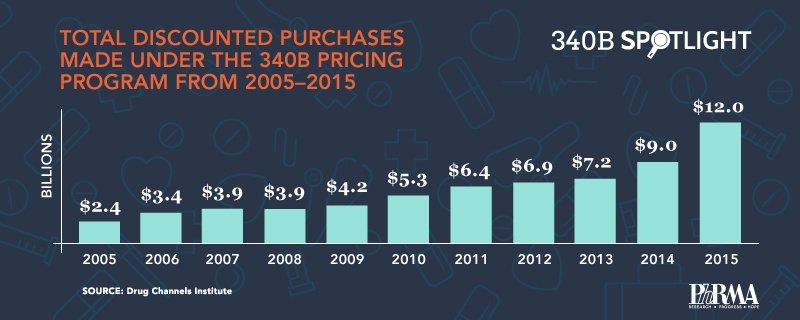340B Spotlight: Program continues to grow with no end in sight
340B purchase data show the program continues to grow while uninsured rate continue to decline.

340B Spotlight: Program continues to grow with no end in sight.
340B purchase data show the program continues to grow while uninsured rate continue to decline.

340B Spotlight: Program continues to grow with no end in sight.
 How much is the 340B program growing? Earlier this year, Drug Channels published new 340B purchase data from Apexus, the 340B program’s Prime Vendor. Apexus’s data show $12 billion of drug sales at the 340B price in 2015, a number that continues to grow. This is up from $9 billion in 2014, an increase of 33 percent over one year and more than 67 percent higher than 2013 sales. These numbers are even more alarming when you realize they underestimate the total sales going through the program because 5 to 10 percent of 340B sales do not go through Apexus. [1]
How much is the 340B program growing? Earlier this year, Drug Channels published new 340B purchase data from Apexus, the 340B program’s Prime Vendor. Apexus’s data show $12 billion of drug sales at the 340B price in 2015, a number that continues to grow. This is up from $9 billion in 2014, an increase of 33 percent over one year and more than 67 percent higher than 2013 sales. These numbers are even more alarming when you realize they underestimate the total sales going through the program because 5 to 10 percent of 340B sales do not go through Apexus. [1]

We know 81 percent of 340B purchases are made by disproportionate share hospitals (DSH) despite the fact that these hospitals represent only 9 percent of participating covered entities.[2],[3] Drug Channels’ analysis estimates hospitals are now receiving 340B discounts on nearly half (44 percent) of their drug purchases, providing further evidence that hospitals are driving current volume and future program growth. This new data combined with multiple reports on the low levels of charity care[4] and uncompensated care[5] that DSH hospitals provide raise important questions about the sustainability of the program and whether it is still consistent with the law’s original intent.
Curiously, the uninsured rate continues to decline,[6] while the 340B program continues to grow. Having grown considerably since it was created in 1992, these sales numbers show there’s no sign of that growth slowing anytime soon. Given the growth in 340B sales, the decline in the number of uninsured and the outsized role that DSH hospitals are playing in the program, policymakers should take a fresh look at the 340B program and its role in distorting the health care market more broadly.
[1] Direct 340B drug sales, 340B drug sales through certain specialty distributors, or ADAP rebate sales are not included in Apexus’ number. A recent MedPAC report that noted that 90 percent to 95 percent of all 340B purchases are made through Apexus. MedPAC, “Report to the Congress: Overview of the 340B Drug Pricing Program”, (May 2015), accessed at: http://www.medpac.gov/documents/reports/may-2015-report-to-the-congress-overview-of-the-340b-drug-pricing-program.pdf?sfvrsn=0
[2] Hatwig C. Apexus update 2015 (sales data). Presented at: 340B Coalition Winter Conference.
[3] Avalere Health analysis of Health Resources and Services Administration Office of Pharmacy Affairs 340B Database. http://opanet.hrsa.gov/opa/CESearch.aspx. Accessed March 2015.
[4] http://340breform.org/userfiles/May%202016%20AIR340B%20Avalere%20Charity%20Care%20Study.pdf
[5] http://www.gao.gov/products/GAO-16-568
[6] http://www.gallup.com/poll/190484/uninsured-rate-lowest-eight-year-trend.aspx